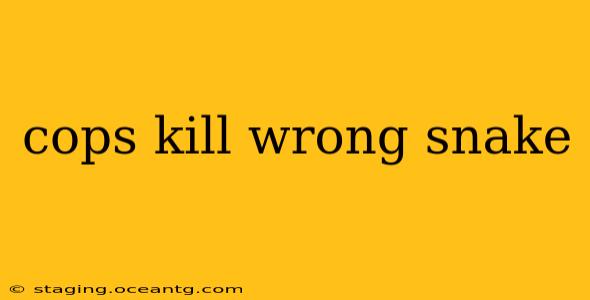The recent incident where police officers mistakenly killed a non-venomous snake, believing it to be a dangerous species, highlights a critical issue: the dangers of misidentification and the importance of accurate snake identification before taking action. This tragic event underscores the need for better training and a more cautious approach when dealing with wildlife, particularly snakes. This article will delve into the specifics of such incidents, exploring the reasons behind the mistakes and offering solutions to prevent future occurrences.
Why Do Such Mistakes Happen?
Several factors contribute to the tragic misidentification of snakes leading to their unnecessary deaths.
-
Lack of Proper Training: Police officers and other first responders often lack sufficient training in snake identification. They may rely on limited knowledge or outdated information, leading to incorrect assumptions about a snake's venomousness. Distinguishing between venomous and non-venomous snakes requires detailed knowledge of physical characteristics, behavioral patterns, and regional variations within species.
-
Time Constraints and Pressure: In emergency situations, time is of the essence. The pressure to act quickly might lead officers to make hasty decisions without taking the time for proper identification. Fear of a potential threat to public safety, particularly if children are nearby, understandably influences decision-making.
-
Visual Similarity: Many non-venomous snakes share visual similarities with venomous species. This can be especially confusing for individuals lacking expertise in herpetology. Even subtle differences in color patterns, scales, or head shape can be crucial for accurate identification, yet easily overlooked under pressure.
-
Fear and Misinformation: Fear and misinformation about snakes are widespread. Negative stereotypes and exaggerated perceptions of the danger posed by all snakes contribute to an instinctive reaction to kill rather than identify. This reaction is often amplified by the lack of reliable information.
What Happens When Police Kill the Wrong Snake?
Beyond the obvious loss of a harmless animal, the killing of a non-venomous snake has wider implications.
-
Ecological Disruption: Snakes play a vital role in maintaining ecological balance. Removing them, even non-venomous ones, can disrupt the food chain and have unintended consequences for the local ecosystem.
-
Public Trust Erosion: Incidents of this nature can damage public trust in law enforcement and wildlife management agencies. Mistakes undermine credibility and raise questions about the competence and training of those responsible.
-
Waste of Resources: Killing a non-venomous snake constitutes a waste of resources—time, personnel, and potentially, ammunition. These resources could have been better allocated to addressing genuine threats.
How Can We Prevent Future Incidents?
Several steps can be taken to reduce the likelihood of similar incidents:
-
Improved Training: Law enforcement agencies and other first responders should receive comprehensive training in snake identification, focusing on regional species and emphasizing the importance of accurate identification before taking action. This training should involve experienced herpetologists and utilize practical exercises and visual aids.
-
Enhanced Public Education: Public awareness campaigns can educate citizens about snake identification, dispelling myths and fostering a more informed and less fearful approach to wildlife.
-
Development of Clear Protocols: Establish clear protocols for handling snake encounters, prioritizing safe identification and non-lethal methods of relocation whenever possible. These protocols should be readily available to all first responders.
-
Use of Expert Consultation: When dealing with an ambiguous situation, law enforcement should have readily available access to experts in herpetology who can provide quick and accurate identification.
What Should You Do If You Encounter a Snake?
If you encounter a snake, remember:
- Observe from a safe distance: Do not approach or attempt to handle the snake.
- Attempt to Identify the Snake: If possible, take a picture from a safe distance for later identification. Use online resources or contact a local herpetologist or wildlife agency for assistance.
- Contact Local Authorities: If you believe the snake poses an immediate threat, contact your local animal control or wildlife agency.
The tragic killing of a non-venomous snake underscores the critical need for improved training, accurate identification techniques, and a more cautious approach when dealing with wildlife. By addressing these issues, we can prevent future incidents and preserve the ecological balance of our communities.
